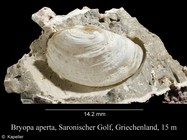MolluscaBase taxon details
Bryopa Gray, 1847
390892 (urn:lsid:marinespecies.org:taxname:390892)
accepted
Genus
Clavagella aperta G. B. Sowerby I, 1823 accepted as Bryopa aperta (G. B. Sowerby I, 1823) (type by original designation)
Clavagella (Bryopa) Gray, 1847 · alternative representation
Tiria De Gregorio, 1886 · unaccepted
- Species Bryopa aligamenta B. Morton, 2005
- Species Bryopa aperta (G. B. Sowerby I, 1823)
- Species Bryopa lata (Broderip, 1834)
- Species Bryopa melitensis (Broderip, 1834)
- Species Bryopa astraeicola Jousseaume, 1923 accepted as Bryopa lata (Broderip, 1834)
- Species Bryopa senilis Jousseaume, 1923 accepted as Bryopa lata (Broderip, 1834)
- Species Bryopa socialis Jousseaume, 1923 accepted as Bryopa lata (Broderip, 1834)
marine
Gray, J. E. (1847). A list of the genera of recent Mollusca, their synonyma and types. <em>Proceedings of the Zoological Society of London.</em> (1847) 15: 129-219. [November 1847]., available online at http://biodiversitylibrary.org/page/12862913
page(s): 188 [details]
page(s): 188 [details]
Taxonomy In his overview paper, Morton (2007) separated off a family Penicillidae for Penicillus, Brechites, Foegia, Nipponoclava,...
Taxonomy In his overview paper, Morton (2007) separated off a family Penicillidae for Penicillus, Brechites, Foegia, Nipponoclava, Kendrickiana and Humphreyia, from the Clavagelidae containing the extinct genus Clavagella and the extant genera Dacosta, Bryopa, Dianadema and Stirpulina. The tube or "crypt" in which these taxa live in the sediment, or attached to shells, etc., is formed in quite different ways in the two families, and Morton (2007) suggested that they evolved from distinct lyonsiid ancestors. This view is disregarded by Huber (2010) who finds this splitting exaggerated and considers all the Clavagellidae sensu Morton (2007) as subgenera of Clavagella Lamarck, 1818 [details]
MolluscaBase eds. (2024). MolluscaBase. Bryopa Gray, 1847. Accessed at: https://www.molluscabase.org/aphia.php?p=taxdetails&id=390892 on 2024-11-14
Date
action
by
![]() The webpage text is licensed under a Creative Commons Attribution 4.0 License
The webpage text is licensed under a Creative Commons Attribution 4.0 License
original description
Gray, J. E. (1847). A list of the genera of recent Mollusca, their synonyma and types. <em>Proceedings of the Zoological Society of London.</em> (1847) 15: 129-219. [November 1847]., available online at http://biodiversitylibrary.org/page/12862913
page(s): 188 [details]
original description (of Tiria De Gregorio, 1886) De Gregorio, A. (1886). Nota intorno ad alcune conchiglie mediterranee viventi e fossili. <em>Il Naturalista Siciliano.</em> 5 (12): 259-265., available online at https://www.biodiversitylibrary.org/page/30388488
page(s): p. 263. [details]
basis of record Morton, B. (2007). The evolution of the watering pot shells (Bivalvia, Anomalodesmata: Clavagellidae and Penicillidae). <em>Records of the Western Australian Museum.</em> 24 (1): 19-64., available online at https://doi.org/10.18195/issn.0312-3162.24(1).2007.019-064 [details]
page(s): 188 [details]
original description (of Tiria De Gregorio, 1886) De Gregorio, A. (1886). Nota intorno ad alcune conchiglie mediterranee viventi e fossili. <em>Il Naturalista Siciliano.</em> 5 (12): 259-265., available online at https://www.biodiversitylibrary.org/page/30388488
page(s): p. 263. [details]
basis of record Morton, B. (2007). The evolution of the watering pot shells (Bivalvia, Anomalodesmata: Clavagellidae and Penicillidae). <em>Records of the Western Australian Museum.</em> 24 (1): 19-64., available online at https://doi.org/10.18195/issn.0312-3162.24(1).2007.019-064 [details]
From editor or global species database
Taxonomy In his overview paper, Morton (2007) separated off a family Penicillidae for Penicillus, Brechites, Foegia, Nipponoclava, Kendrickiana and Humphreyia, from the Clavagelidae containing the extinct genus Clavagella and the extant genera Dacosta, Bryopa, Dianadema and Stirpulina. The tube or "crypt" in which these taxa live in the sediment, or attached to shells, etc., is formed in quite different ways in the two families, and Morton (2007) suggested that they evolved from distinct lyonsiid ancestors. This view is disregarded by Huber (2010) who finds this splitting exaggerated and considers all the Clavagellidae sensu Morton (2007) as subgenera of Clavagella Lamarck, 1818 [details]


